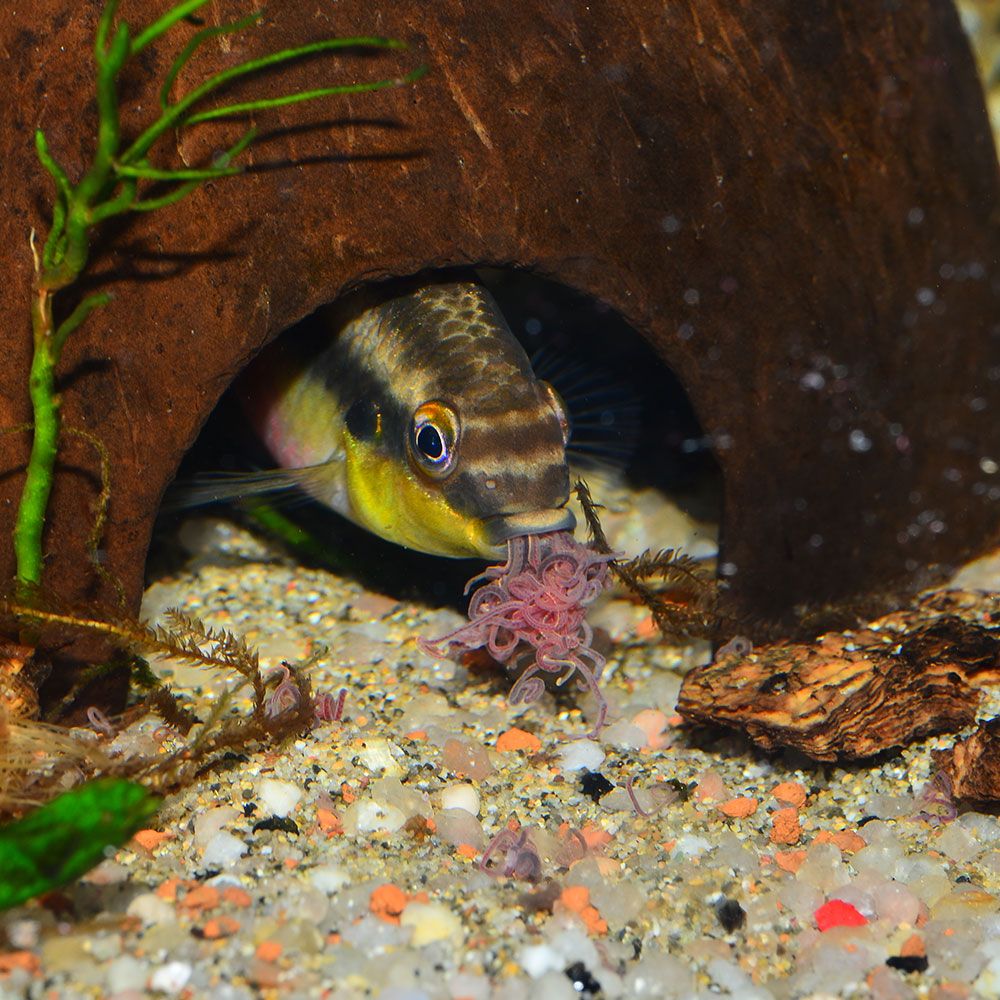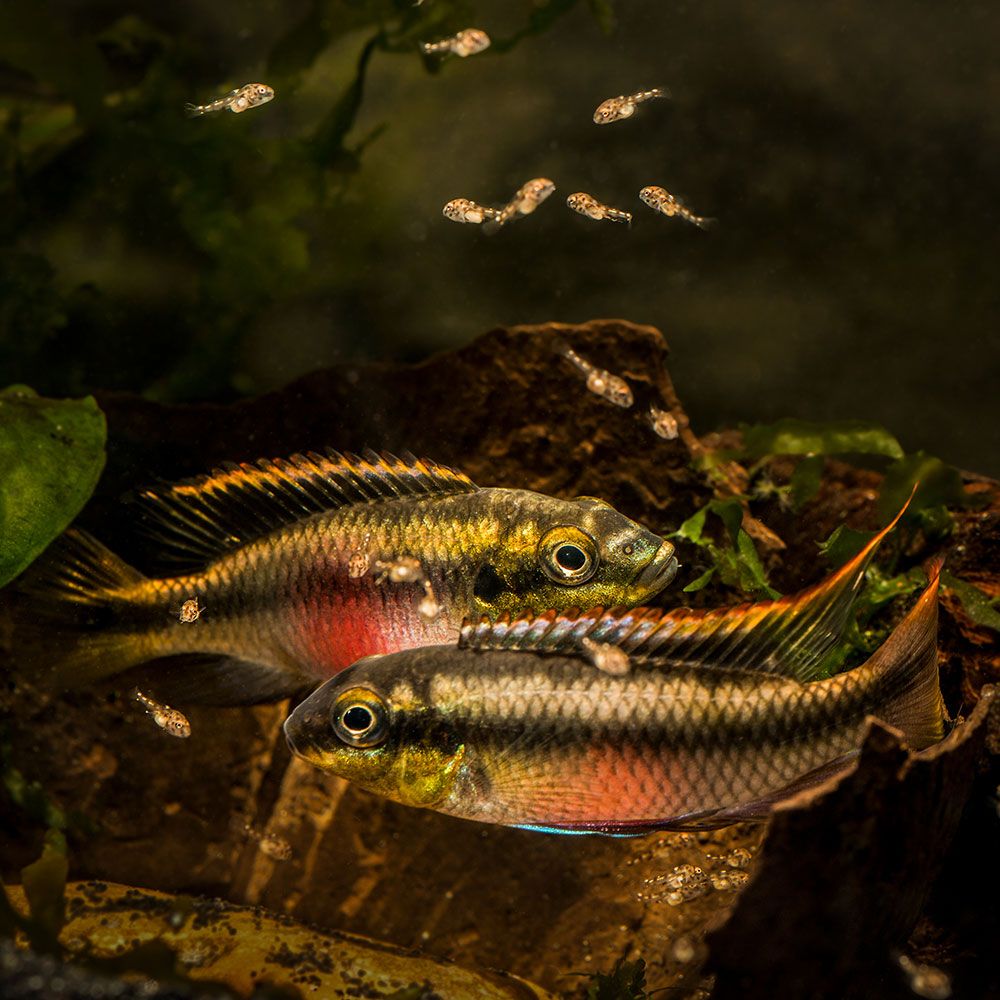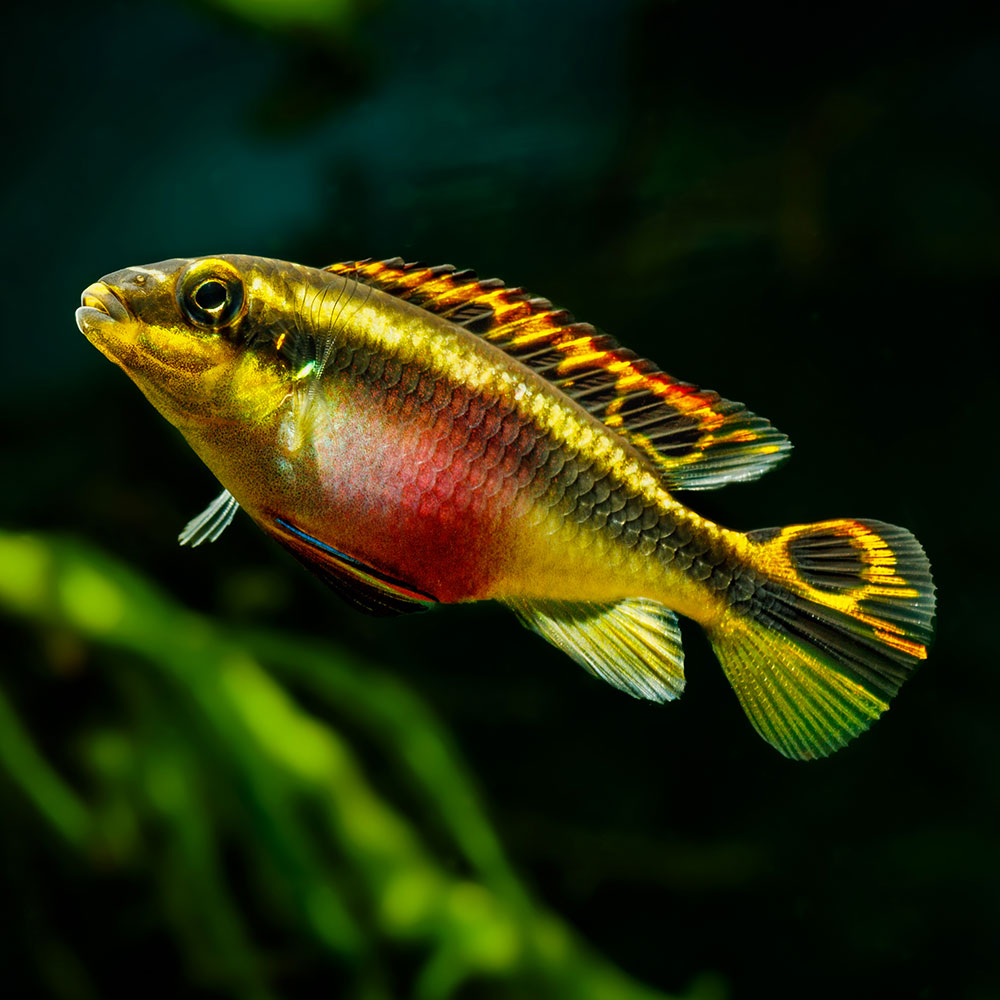The kribensis cichlid is one of the peaceful dwarf cichlids that never got the attention it should have. You won’t believe this vibrant fish got so many different names that aquarists find it challenging to keep track of it.
This lovely, zero-fuss species is best suited for slightly experienced aquarists. It can be a great addition to almost all peaceful freshwater community tanks.
What is a Kribensis Cichlid?
Kribensis cichlid is a freshwater fish that is a type of a dwarf cichlid and is popular among intermediate level fish keepers and aquarists.
| Origin | Nigeria, Cameroon, Benin, Africa |
| Order | Perciformes |
| Family | Cichlidae |
| Scientific Name | Pelvicachromis pulcher |
| Common Names | Kribensis cichlid, tilapia, rainbow cichlid, rainbow krib, red krib, super-red krib, purple cichlid, common krib |
| IUCN Red List Status | Least Concern |
| Appearance | Elongated, slim grey to white-bodied fish with red pigment around the belly, orange-yellow fins, red/yellow gill covers |
| Size | Up to 10 cm (3.9 in) for males, Up to 8 cm (3.15 in) for females |
| Lifespan | Up to 5 years with the best care |
| Temperament | Usually peaceful, aggressive, and territorial during mating season |
| Tank Level | Bottom and middle-level dwellers |
| Water Temperature | 75-79 °F (24-26 °C) |
| pH Level | 5.5-7.5 |
| Water Hardness | Up to 10 dGH |
| Care Level | Intermediate |
| Minimum Tank Size | 30 gallons for a pair, 40 gallons for breeding, 50 gallons for a community tank |
| Tank Environment | Spacious, vegetated, dimly lit tank |
| Diet | Primarily carnivorous, but accepts omnivorous feed |
| Tank Mates | Own mate, other peaceful and similar-sized species that inhabit other water columns |
What is the Natural Habitat of Kribensis Cichlid?
Naturally, kribensis cichlid is spotted in the freshwater wetlands of Southern Nigeria, Western Cameroon, and Eastern Benin of Africa. The fish swims mainly in the demersal regions of the brackish water bodies of these areas.
According to The IUCN Red List Status of Threatened Species assessment 2019, this fish was marked Least Concern.
Which family does Kribensis Cichlid belong?
The fish belongs to the Cichlidae family under the Perciformes order and is scientifically known as Pelvicachromis pulcher.
However, the fish is popular worldwide by a variety of names, like kribensis cichlid, kribensis, common krib, red krib, super-red krib, rainbow krib, rainbow cichlid, tilapia, and purple cichlid.
Fun Fact: The scientific name of the fish means “a fish with an attractive belly.”
How does Kribensis Cichlid look?

Now, if you’re curious about the beauty of this fish, let’s get right into the details here!
What is the Size of Kribensis Cichlid?
Commonly, the adult male Kribensis grows up to 10 cm (3.9 in). While the adult female fish is as long as 8 cm (3.15 in). However, the largest size for this species is reported to be 11 cm (4.3 in).
What is the Color of Kribensis Cichlid?
The naturally found Kribensis cichlid exhibits a grey or white base body color and a black horizontal stripe extending from the eyes to the tail fin.
There’s a white region above this area, along with a dark stripe on the dorsum. It has orange and yellow fins, red or yellow gill covers, and a red abdomen. The tail base has a dark pigmentation, and the upper half of the tail fin and the dorsal fin has several black dots.
However, the fish is available in different morphs – red, yellow, blue, green, and albino which vary depending on the origin of the fish.
What are the Features of Kribensis Cichlid?
The fish has a tall, slim, elongated, and slightly compressed body with a round head. While its head is around a third of its standard body length, its body depth is about a third to half the standard length of the body.
Rainbow krib also has pharyngeal teeth other than its teeth in the mouth. The krib can also smell the water and detect the presence of predators and prey.
What is the difference between a male and a female Kribensis Cichlid?
The adult male fish is visibly longer than the female kribensis cichlid. The male fish also has much more pointed dorsal, anal, and tail fins than the female.
The female fish is rounder than the male and exhibits a purplish or pinkish-red abdomen. This hue is much brighter and more saturated than the male’s abdomen.
What is the Behavior & Temperament of Kribensis Cichlid?
Kribensis cichlid is commonly shy and peaceful towards its own kind and other species so long it’s housed in a spacious tank.
However, it turns extremely territorial and aggressive while spawning. It might even nip other fish’s fins if they try to enter its territory or nesting region.
What is the Lifespan of Kribensis Cichlid?
In captivity, kribensis cichlid usually lasts for 5 years with care. However, in my experience, it’s possible to extend the lifespan to 6 years with proper vigilance.
Author’s Note: The fish is monogamous and bonds with one mate for life. It won’t entertain another suitor when it already has a mate.
How to take care of Kribensis Cichlid?

Now, if you can’t wait to get this fish for your aquarium, let’s read more about how to care for it!
What is the Tank Size for Kribensis Cichlid?
The kribensis cichlid must be housed at least in pairs. For that, you may need at least a 30-gallon tank.
However, if you want to house about 4-5 kribensis cichlids or want to put one in a community tank, then you need to start with a 50-gallon tank. The size must increase as you add tank mates.
On the other hand, if you have a bonded pair or want to breed kribensis cichlids, you must prepare a 40-gallon tank.
What is the Water Chemistry for Kribensis Cichlid?
Kribensis cichlids don’t have a long lifespan. So, to sustain the fish for as long as possible, strictly maintain the following water requirements.
- pH Levels: 5.5-7.5
- Water Temperature: 75-79 °F (24-26 °C)
- Water Hardness: Up to 10 dGH
- Ammonia: 0 ppm
- Nitrite: 0 ppm
- Nitrate: Below 30 ppm
What is the Tank Environment for Kribensis Cichlid?
Your next responsibility is to make the fish feel safe and happy by giving it the right atmosphere. So, here’s your guide on how to do that!
Which Substrate is needed for Kribensis Cichlid?
Use a fine, smooth, and dark sand substrate to protect the fish from unwanted cuts. The dark color will also help the fish feel safe and make it stand out in your tank.
Which Plants are required for Kribensis Cichlid?
Add dense vegetation in your aquarium to help kribensis get shelter whenever it feels insecure. You can add both live and plastic plants to the tank. The fish usually doesn’t eat plants, but it has a bad rap about uprooting them.
What type of Lighting is required for Kribensis Cichlid?
Use dim lighting in the tank, and you can further disperse it using floating plants.
What Décor is needed for Kribensis Cichlid?
You can add a variety of hiding spots in your tank, like caves, driftwood, coconut shells, roots, clay pots, and vases. You can also add flat rocks as spawning sites. Ensure that all of the decor has smoothened surfaces.
Which Filtration system is required for Kribensis Cichlid?
A reliable and efficient oxygenating filtration system is necessary for your tank. It must be able to get rid of ammonia, nitrate, and nitrites ASAP.
What is the Water Flow Rate for Kribensis Cichlid?
A gentle to moderate water flow can work great for this cichlid.
Fish Care Tip: Always test your water twice a week to maintain pristine conditions in your tank and avoid diseases. Perform a 25% water change every two weeks for a healthy environment.
What food does Kribensis Cichlid eat?
The kribensis cichlid can accept all kinds of food. It will eat anything that fits its mouth in the wild and aquaria. However, it loves carnivorous meals and is also known to be a scavenger.
To keep it healthy, you must follow a nutritious and balanced diet with mostly live or frozen meaty food and fewer veggies, including:
- High-quality cichlid pellets
- High-quality flake foods
- Daphnia
- Bloodworm
- Crustaceans
- Insects
- Brine shrimp (regular and freshly hatched)
- Mosquito larvae
- Small fish
- Straws
- Blanched, chopped, or mashed vegetables like peas and zucchini
- Chopped fruits
Remember to feed the fish twice a day, with each meal being 2-5 pinches.
What are the Tank Mates for Kribensis Cichlid?
If you want to build a community tank with a kribensis cichlid, you must first ensure it stays in a pair. However, if both specimens are males, they may start fighting each other when they mature. So, ensure the other one is a female.
Next, you can add more peaceful and similar-sized tank mates that occupy the other water columns like these:
- Congo tetras
- Other similar-sized plecos
- Apistogramma, aka dwarf cichlids
- Siamese algae eaters
- Harlequin rasboras
- Tiger barbs
- Danios
- Gouramis
- Platies
- Mollies
- Swordtails
- Kuhli loaches
- Cherry barbs
- Small loricariids
You can also build a cichlid-only tank with other West African dwarf cichlids. However, you must ensure that every species is paired and the tank is big enough to house all of these species in the lower water columns. Otherwise, territorial fights might break out.
Which Tank Mates to Avoid for Kribensis Cichlid?
To keep your red krib happy and safe in its own home, you must avoid the following types of species:
- Any small species that fit its mouth – the krib will feast on them
- Larger, lively, or aggressive species – the fish will feel insecure and might fall sick
- Species that live in the bottom and middle column – competition for food; the fish is territorial during mating season and can’t stand others in its region
- Species with long fins or slow swimmers – it may nip on their fins during the mating season out of aggression
Namely, some fish to avoid are:
- Corydoras
- Freshwater angelfish
- Convict cichlids
- Oscars
- Jack Dempsey cichlids
- Flowerhorn cichlids
- Plecostomus
- Arowanas
- Big tetras
What are the Common Diseases in Kribensis Cichlid?
Kribensis cichlids can stay healthy only until you can maintain top-notch water conditions. However, to err is human, so be prepared to deal with these diseases.
| Disease Name | Causes | Symptoms | Treatment |
|---|---|---|---|
| Ich | Protozoan Parasitic Infection | White patches, flashing, appetite loss, drowsiness | Elevate aquarium temperature, add ich medicine or aquarium salt |
| Fin Rot | Bacterial Infection | Fin fraying or disintegrating, fin discoloration or reddening, appetite loss, drowsiness | Enhances water quality, get rid of hurtful objects, add antibiotics |
| Dropsy | Infection, stress, poor water | Bloated belly, ulcers, scale protruding around the fins and vents | Maintain proper diet, perform regular water changes, add medicines |
| Columnaris | Bacterial Infection | White or grey patches, fin fraying, appetite loss, drowsiness | Improve water quality, get rid of stress source, add antibiotics |
| Hexamita | Protozoan Parasitic Infection | Color fading, head hammerrage, holes or sores on head, red feces, appetite loss, drowsiness | Quick antifungal treatment |
| Gill Disease | Infection, poor water quality | Discolored or swollen gills, excess mucus secretion, harsh breathing, appetite loss, drowsiness | Regular partial water changes, quarantine, add medicines |
| Fish Tuberculosis | Bacterial Infection | No symptoms. Sudden consecutive fish death and positive testing for the disease | Supportive care. Prevention: Quarantine new fish before adding to tank, clean all food, and sterilize all decor before adding to the aquarium |
| Pop-Eye | Immune response to injury | Swollen and protruding eyes, cloudy eyes | Reduce feeding frequency and food amount, enhance water quality, feed a fibrous diet, reduce stress, add medicine |
| Swim Bladder Disease | Bacterial Infection, high nitrate concentration, sharp temperature fluctuation | Fish floating on the water surface, swimming abnormally – sideways, curved path, or upside down | Improve water maintenance, fast fish for 3 days and then feed deskinned and cooked mashed peas, fix temperature |
Quick Tip: Always keep a spare 30-gallon tank handy to quarantine sick fish and treat them separately.
How to Breed Kribensis Cichlid?
It’s pretty easy to breed kribs, but you must still take proper measurements and avoid spontaneous spawning, as that increases the chances of fry loss. Now if you’re ready, here’s how you can breed them:
What is the Pair Obtaining & Conditioning Process for Kribensis Cichlid?
You can buy a bonded pair from shops. Or, buy a group of kribensis cichlids and let them naturally pair up.
Don’t buy a male and female, as there’s no chance they’ll be compatible. Rather, unwilling partners might even kill each other.
Remember, the fish reaches sexual maturity at 6 months, so be certain about the fish’s age.
Once you get the pair, feed them a high-protein diet of live, dried, or frozen carnivorous meals.
What is the Tank Preparation for Kribensis Cichlid?
In a 40-gallon tank, maintain the following parameters:
- Water Temperature: 75-81 °F (24-27 °C)
- pH Levels: 6.5-7.0
- Water Hardness: Up to 10 dGH
Add lots of caves (as the species is a cave spawner) and toppled-down pots. Add fine and smooth sand substrate, the pair may bury and hide their eggs in sandpits, but sand will be easy for you to move.
Use a gentle sponge filter in the tank to avoid the fry from getting sucked into it.
What is the Mating Process for Kribensis Cichlid?
Introduce the pair in the breeding tank and wait for them to mate. If they don’t spawn after days, you can add dither fish (a school of tetras) to help the pair feel more secure to come out and mate.
When the pair is ready to spawn, the male’s overall body color intensifies, and the female’s belly turns bright purple.
The female then courts the male fish by dancing around him and flaunting her bright belly. She also curls her fins and arches her body.
Once the male is ready, they choose spawning sites together, usually a cave or a sandpit.
The female then lays up to 70-300 eggs on the selected sites, and the male fertilizes them. After that, she stays with the eggs in the cave to care for them. You may only see her during the mealtimes.
Meanwhile, the male stands by to protect the entire territory.
What is the Incubation Periof for Kribensis Cichlid Eggs?
After 2-3 days, the eggs hatch, and the fry consumes its yolk under parental protection. You may not notice the newly-hatched fry because the pair hides and protects young ones strategically.
From the day of hatching, after 7-8 more days, the fry become free swimmers. This is when you might suddenly notice a huge mass of small speckled fry darting around and following the parent fish.
If any young fish goes astray, the parent fish sucks it into its mouth and spits it back into the group.
Now, you must add extra food multiple times in the tank for the fry. You can give commercially available fry foods, but other choices are crushed fish flakes, infusoria, microworms, and freshly hatched brine shrimp.
Let the young fish stay under parental care until they show signs of spawning again. However, one parent may take over the custody of all young ones. If the other parent shows aggression for losing the babies, remove the other parent ASAP.
How to Maintain the Fry tank for Kribensis Cichlid?
Take great care of water quality. Regularly perform water changes; otherwise, it may kill the young fry.
But be careful not to touch the water column or areawhere you see the young fry or near their cave; otherwise, it will stress the young fish.
When to Separate Kribensis Cichlid Fry from its Parents?
After 2-4 weeks, the fry grows to 1.3 cm (0.5 in); relocate the parents or fry. The fry no longer needs parental care then. You can condition the pair to breed once more.
Breeding Tips
- Be extremely precise about the breeding tank for an almost equal number of males and females.
- Excess water acidity (pH less than 6.5) may lead to a majority of female fry. Excess alkalinity of water (pH more than 7.0) leads to spawning too many males.
How to Buy Kribensis Cichlid?
- If you buy a group of adult kribensis cichlids from the shop, choose the largest males and the most brightly-colored females.
- Buy kribensis cichlids only when they are 1 inch long. Younger fish don’t get accustomed to sudden environmental changes.
A word from FishInAquarium
Kribensis cichlids add a splash of multiple bright colors to your tank. So, whenever they swim around, it seems as though the rainbow is moving around. It also befriends other species easily.
So, if this article convinced you to show some love to this species, definitely share it with other fish enthusiasts. Let them jump on the bandwagon along with you. And if you have more questions on your journey, definitely drop a mail, and we’ll sort out all the confusion!


